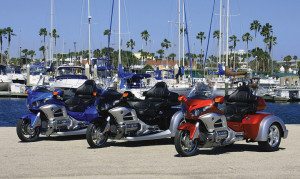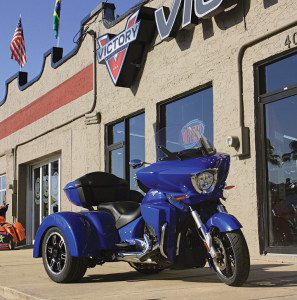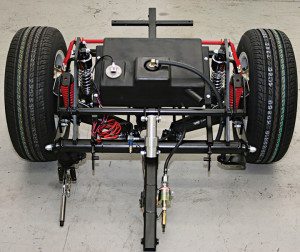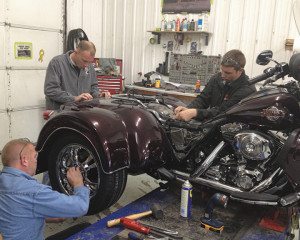‘Full-on optimism’ for trike maker
Roadsmith sets record year in 2012 with 40 percent growth
For the aging touring and cruising crowd, trikes are a way for them to stay in the sport, while maintaining a greater sense of security with three-wheel stability. Roadsmith Trikes out of White Bear Lake, Minn., is one of the leaders in the trike segment. Powersports Business managing editor Liz Hochstedler caught up with Kirk Rush, director of marketing and dealer support of Roadsmith, at Dealer Expo, where the company was introducing its new HTS1800 kit for the 2012 and newer Gold Wing. The company is experiencing growth and looking to expand its dealer network.
PSB: How was business in 2012?

Kirk Rush: Our business was up 40 percent year-over-year. It was the biggest year that the company’s ever had in its 41-year history.
PSB: How does Roadsmith Trikes work with dealers?
KR: In most cases we provide manufacturer kits to our dealers, and they install them. A majority of our dealers get painted kits from us. We have several high-volume dealers that buy larger quantities, and they buy unpainted units. They have their own in-house paint capabilities. But the majority of our dealers buy kits from us and install them on their customers’ bikes.
PSB: What’s the procedure for a consumer purchasing one of your trikes?

KR: There are two ways of going about getting a trike. You can either buy a completed trike off the showroom floor or you trike your own bike. I would say the majority of our business is people who are getting a little bit older, they may have dropped the bike one time, and are a little uncomfortable keeping up. They go into one of our dealers and say, ‘I want to trike my bike.’ That’s how most of our trikes get on the road. Then we have guys like Mike McGrath [of McGrath Powersports in Cedar Rapids, Iowa], who takes brand new Gold Wing units and trikes them and puts them on the showroom floor.
PSB: What’s your process for bringing in a new dealer?
KR: If a dealer comes to us, we have very low barriers to entry for our dealers. We require a minimum purchase of two trike kits. If a dealer says, ‘I’m interested in getting into the trike business because I’ve got a customer who wants to trike his Gold Wing,’ you’re halfway there. You’ve got one sale already. It’s usually not a big deal for somebody who is serious about getting into the trike business, but you don’t have to be all that serious. The other big advantage that we offer to our dealers is we have training at our factory, and we actually will build your first kit for you.
PSB: How does that work?

KR: You bring a motorcycle to our factory, and we will build that first kit for you. You participate to whatever degree you want to alongside our Honda or Harley-Davidson technicians. You’re taking notes, and you’re watching, you’re helping, whatever. You leave there with a finished trike, and you take the other kit with you. We recommend that our dealers get our chassis display stand, because believe it or not, even though you’ve got all these pretty, shiny trikes to sell, showing the chassis really generates a lot of interest. Riders want to know how it works, what’s replaceable. We have virtually no maintenance on the kit for 100,000 miles, which is really great. We ask the dealer to take the second chassis that he hasn’t sold yet, and instead of putting in the back room and letting it collect dust, put it in the showroom on the display stand. You’ve got a point-of-sale selling tool. When you sell that one, you put it on the bike, order another one, and you’re back in business, keeping the cycle going.
PSB: How large is your dealer network right now?
KR: We have about 125 dealers. The majority of our dealers are east of the Mississippi. We have fewer dealers out west, in fact we have no dealers in California.
PSB: Why would a dealer want to carry your trike conversion kits as opposed to another company’s trike conversion kit?
KR: One of the advantages of Roadsmith is we’ve been in business for 41 years. People always say, ‘What’s the difference between you and California Sidecar, or Lehman, or whoever?’ We’ve been in business for 41 years building trikes. We started out building Volkswagen trikes in 1972. We have used all of that know-how — all of that engineering know-how — and all of those Volkswagen components have evolved just like we have. We still use Volkswagen components in our chassis for two reasons: Number one, they’re easy to get. God forbid we go out of business, and we have some proprietary brake shoe or something that you can no longer get. So we do it for that, but also because it’s a heavy-duty solution for a light-duty application. We give a three-year unlimited mileage warranty on our kits, but we want those kits to last for 100,000 miles, and the way these things are built — with the design, engineering and the production — they will last 100,000 miles.
PSB: Which models do your trike kits fit?

KR: We sell kits for Hondas, Harleys, Victorys and Indians. For Hondas — our biggest seller — we do the 1800, 1500, the Gold Wing 1500; we do the VTX1300, the Valkyrie 1300 and the VTX1800. In the Harley category, we do the FLH touring bikes, Softails and Sportsters. We have a lot of Harley dealers that are Roadsmith dealers. In fact, Rossmeyer’s in Daytona is a huge Roadsmith dealer.
PSB: Do you have dealers who, even though most of their trike buyers may be converting an already-purchased unit, they’re still converting one for the showroom floor?
KR: We like for all of our dealers to have one demo, whether that’s a new unit that they’re converting or a used unit. We like for all of our dealers to have at least one demo unit because the proof is in the pudding with a trike. Typically, if people haven’t ridden one before, you really need to put their butt in the seat, as they say, so they can experience what it’s like to ride a trike.
PSB: Do any of your dealers ever convert non-moving used units into trikes to give them more appeal?

KR: Absolutely. You’ll find a guy that’s got a unit that hasn’t sold, and he’s like, ‘OK, well maybe there’s a trike buyer.’ What amazes me about this business is how regional it is, how in some places guys are selling tons of trikes, and in other places trikes just aren’t moving that well. But it also comes down to, I think, the dealer environment, the dealer commitment to trikes and their salespeople and the whole trickle-down thing — if the boss believes in trikes, then he’s going to push that to his salespeople, and as you know, salespeople will gravitate to the point of least resistance. They’ll sell what they’re comfortable selling, and if they’re not comfortable selling trikes, and the boss isn’t pushing it, it isn’t going to sell, and it will sit there for a while.
PSB: What do you think you’ll see for 2013? Do you think you’ll see the same upward trend?
KR: I used to say I was cautiously optimistic about 2013, but I’m no longer cautiously optimistic; I’m full-on optimistic. I don’t think we’ll see quite the trajectory year-over-year because we can’t grow 40 percent every year, but I think we will grow, and here’s what I’m basing that on. Typically we have two pretty bad months, slow months. We call it the off-season in December and January. The production board has not gone unfilled during the entire slow period, and we were booked through February and March. With this new kit introduction, we’ve very confident that all of our dealers are going to want to get that new kit.








